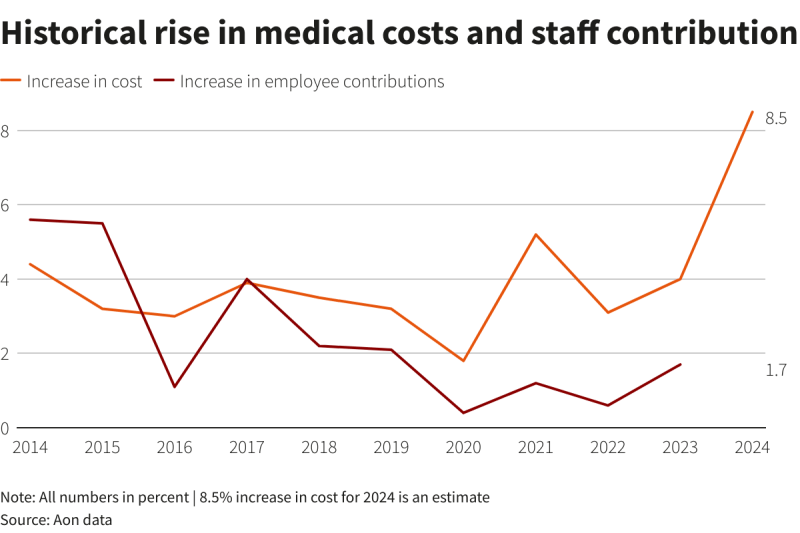How Much Do Employers Pay For Health Insurance Per Employee – Employer-sponsored insurance covers about 153 million disadvantaged people. It conducts an annual survey of private, public, non-union employers with three or more employees to provide a current picture of employer-sponsored health benefits. This is the 25th Employer Health Benefits Survey (EHBS) and shows employer-sponsored health benefits in 2023. The survey was conducted from January to July 2023.
The average annual cost for employer-sponsored health insurance in 2023 is $8,435 for single coverage and $23,968 for family coverage. The average annual single and average annual family premium each increased by 7% compared to last year. Compared to this, the wages of workers increased by 5.2% and inflation by 5.82%. Individual and family rates increased faster this year than last year (2% vs. 7% and 1% vs. 7%, respectively).
Contents
- How Much Do Employers Pay For Health Insurance Per Employee
- When Employers Cannot Afford Formal Health Insurance Benefits
- When Does Health Insurance End After Leaving A Job?
- Employer Strategies To Reduce Health Costs And Improve Quality Through Network Configuration
- Worth Of Your Well Being
- Health Benefit Cost Expected To Rise 5.4% In 2024
- Related posts:
How Much Do Employers Pay For Health Insurance Per Employee

Over the past five years, the average premium for family insurance has increased by 22%, compared to a 27% increase in workers’ wages and a 21% increase in inflation [Figure A].
When Employers Cannot Afford Formal Health Insurance Benefits
For single coverage, the average premium is higher for covered workers at small firms than at large firms ($8,722 vs. $8,321). Average rates for family coverage are comparable for covered workers at small and large firms ($23,621 vs. $24,104). Average premiums for workers in high-deductible health plans with a savings option (HDHP/SO) are lower than overall average premiums for both single coverage ($7,753) and family coverage ($22,344). [Image B]. In contrast, the average premium for covered workers enrolled in a PPO is higher than the overall average for both individual ($8,906) and family ($25,228) coverage. The average amount for single coverage for workers employed by private for-profit corporations ($8,078) is lower than for workers employed by public ($8,771) or private nonprofit corporations ($9,023). Average premiums for covered workers in companies with a relatively large proportion of older workers (where at least 35% of workers are 50 or older) are lower than average premiums for covered workers in companies with a lower proportion of older workers. are available, both for single coverage. ($8,790 to $8,112) and family coverage ($24,700 to $23,304).
Figure B: Annual employee and employer contributions for single-family coverage, by plan type, 2023
Most covered workers contribute to the cost of premiums for their coverage. On average, covered workers pay 17% of premiums for single coverage and 29% of premiums for family coverage, the same rates as in 2022. Covered workers at smaller companies, on average, contribute a higher percentage of premiums for family coverage than larger companies. (38% to 25%). As a result, the average amount of contributions for covered workers at small businesses ($8,334) is higher than the average amount of contributions for covered workers at large businesses ($5,889).
Covered employees at private for-profit companies have the same premium contribution rates for single coverage (19%). Covered workers in public institutions have relatively low premium contributions for single coverage (13%) and family coverage (24%).
When Does Health Insurance End After Leaving A Job?
About 30 percent of covered small business workers are enrolled in a plan in which the employer pays the full premium for single coverage. This is the case for only 6% of covered workers in large companies. However, 32% of covered employees at small companies are in a plan where they must contribute more than half of the premium for family coverage, compared to 8% of covered employees at large companies [Figure D].
The average dollar amount collected by covered workers in 2023 is $1,401 for single coverage and $6,575 for family coverage, the same amount as last year but higher than five years ago. 11 percent of covered workers, including 25 percent of covered small business workers, are in plans with employee contributions of $12,000 or more for family coverage. Individual and family premium contributions for workers enrolled in HDHP/SO plans are, on average, lower than contributions for workers in other plan types.
Graph D: Distribution of premiums paid by covered workers for individual and family coverage, by company size, 2023

PPOs are the most common type of plan. By 2023, 47% of covered workers will be in a PPO, 29% in a high-quality plan with a savings option (HDHP/SO), 13% in an HMO, 10% in a POS, and 1% be in a tradition. plan (also known as an indemnity plan [Figure E]. This distribution of workers covered by plan type is similar to the distribution of workers covered by plan type in recent years.
Employer Strategies To Reduce Health Costs And Improve Quality Through Network Configuration
Figure E: Distribution of enrollment in covered employee health plans, by plan type and company size, 2018 and 2023
Many companies, especially large ones, are self-funded, that is, they pay directly for their employees’ health services with their own money instead of purchasing health insurance. Sixty-five percent of covered workers are enrolled in self-funded plans, including 18% of covered workers at small firms and 83% of covered workers at large firms. The proportion of workers dependent on self-financed schemes in 2023 is the same as last year.
Thirty-four percent of small businesses that offer health benefits report having a tiered financial plan, the same percentage as in 2022. Regulatory financing arrangements combine a relatively small self-funded component with loss-of-loss insurance, which limits the employer’s liability and transfers a significant portion of the risk to insurers. These plans have the potential to significantly affect competition in the small group market because, unlike insured plans, they use health status in qualifying and underwriting and do not require all of the health benefits offered by other plans. want to find
Ninety percent of workers with single coverage have the standard annual payment that must be met before the plan pays for most services, the same percentage as last year (88%).
Worth Of Your Well Being
In 2023, the deductible amount is the same for workers with single coverage and a $1,735 annual general deductible. The median deductible for covered workers is higher at small firms than at large firms ($2,434 vs. $1,478). Among workers with single coverage and no deductibles, average deductibles have increased 10% over the past five years and 53% over the past decade.
In 2023, among workers with single coverage, 47% of small business workers and 25% of large business workers have annual deductibles of $2,000 or more. Over the past five years, the percentage of covered workers with annual deductibles of $2,000 or more for single coverage increased from 26% to 31% [Figure F].
Some employees in high-deductible health plans also receive contributions from their employers to savings accounts. These contributions can be used to reduce the amount of cost sharing. 7 percent of workers in an HDHP with a health reimbursement agreement (HRA) and 4 percent of workers in a health savings account (HSA-eligible HDHP) make single coverage account contributions equal to or less than get bigger Additionally, 34% of workers enrolled in HDHPs with HRAs and 12% of workers enrolled in HSA-eligible HDHPs receive account contributions that, if applied to their deductible, will reduce the individual’s annual liability by $1,000.
Most covered workers also pay a portion of the cost of the doctor’s office visit, regardless of your plan change. Many covered workers face a copayment (a fixed dollar amount) when they visit a doctor, but some workers require coinsurance (a percentage of the covered amount). Average copays are $26 for primary care and $44 for specialty appointments, and average copay rates are 19% for primary care and 20% for specialty care. This amount is the same as in 2022.
Health Benefit Cost Expected To Rise 5.4% In 2024
Many workers also face high costs for hospitalization or outpatient surgery. 73 percent of covered workers require insurance, 10% have coinsurance, and 8% have both payment and coinsurance for hospital admissions. The average co-pay rate for hospital admissions is 20% and the average co-pay amount is $404. Cost-sharing requirements for outpatient surgery are similar to those for hospital admissions. However, the average fee for outpatient surgery is only $208.
More than nine in ten (93%) covered workers will have to share the cost of emergency room visits out of any gross annual income in 2023. Of these covered workers, 47% co-pay for emergency room visits, 26% require co-insurance and 20% have co-insurance requirements, or whichever is greater. The average copay for an emergency room visit is $217, and the average copay amount is 21%. Average copayment and coinsurance rates are higher for smaller companies than for larger companies.
Almost all covered workers have plans with annual in-network cost-sharing limits for single coverage (called out-of-pocket maximums), although these limits vary widely. Among workers in plans with maximum out-of-pocket maximums for single coverage, 13% are in plans with limits of $2,000 or less, while 21%
Employee forms for employers, average cost per employee for health insurance, can employers pay for employees individual health insurance, employers looking for employee, cost per employee for health insurance, health insurance cost per employee, can employers pay for individual health insurance, how much should you pay for car insurance per month, what do employers pay for health insurance, how much do employers pay for health insurance, how much do companies pay for health insurance per employee, how much should i pay for car insurance per month







